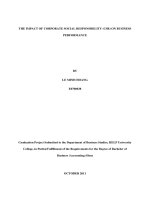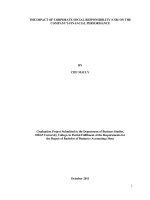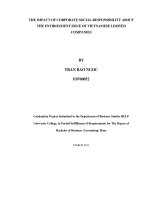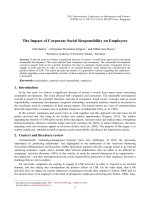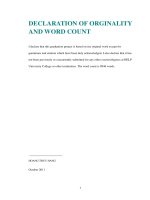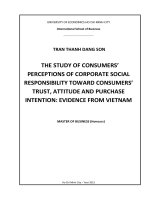The study of consumers perceptions of corporate social responsibility toward consumers trust, attiude and purchase intention evidence from vietnam
Bạn đang xem bản rút gọn của tài liệu. Xem và tải ngay bản đầy đủ của tài liệu tại đây (2.27 MB, 87 trang )
UNIVERSITY OF ECONOMICS HO CHI MINH CITY
International School of Business
------------------------------
TRAN THANH DANG SON
THE STUDY OF CONSUMERS’
PERCEPTIONS OF CORPORATE SOCIAL
RESPONSIBILITY TOWARD CONSUMERS’
TRUST, ATTITUDE AND PURCHASE
INTENTION: EVIDENCE FROM VIETNAM
MASTER OF BUSINESS (Honours)
Ho Chi Minh City – Year 2015
UNIVERSITY OF ECONOMICS HO CHI MINH CITY
International School of Business
------------------------------
TRAN THANH DANG SON
THE STUDY OF CONSUMERS’
PERCEPTIONS OF CORPORATE SOCIAL
RESPONSIBILITY TOWARD CONSUMERS’
TRUST, ATTITUDE AND PURCHASE
INTENTION: EVIDENCE FROM VIETNAM
ID: 22130062
MASTER OF BUSINESS (Honours)
SUPERVISOR: DR. NGUYEN THI MAI TRANG
Ho Chi Minh City – Year 2015
Acknowledgement
This final thesis concluded my academic study at University of Economics
Ho Chi Minh City on the International School of Business (UEH-ISB). Although it
was challenging, I am grateful to have been given this opportunity to study at
UEH- ISB and to conduct this final research. With this work, I have gained a good
knowledge of Corporate Social Responsibility (CSR), which is a new field of
study. Nonetheless, it has received noticeable attention from the academics and
scholars for its recognized roles in the economy.
I hope this study will be
beneficial to the companies when it comes to CSR related decisions.
I offer my sincere appreciation for the invaluable learning opportunities
provided by the committee during thesis process. I would like to personally express
my gratitude to Dr. Nguyen Thi Mai Trang who has actively guided and provided
me with valuable insights and suggestions to my dissertation. Your thorough
review of my dissertation has definitely made it perfect. I am also deeply grateful
to my course mate Ms. Nguyen Thi Ha, who is resourcefulness to me. My family,
especially my wife, deserves special thanks for their valueless contribution to my
education, upbringing and my life in general.
Tran Thanh Dang Son
Abstract
Corporate social responsibility (“CSR”) is currently becoming an emerging
trend in many developing countries over the world. Although the concept of CSR is
a very new-born and unfamiliar with many people; however, Vietnamese consumers
have recently demonstrated their perceptions of CSR through their environmental
concerns, their “go-green” protection, their understanding about the activities of
educational assistance and building houses for the poor performing by enterprises,
etc.
This quantitative research is to examine the factors that encourage
Vietnamese consumers’ purchase intention toward CSR enterprises’ products. The
research is to develop hypothetically suitable theoretical model that is then
empirically tested through an internet survey of 224 respondents in Vietnam. The
respondents are chosen from diverse backgrounds. Structural Equation Modeling
technique is deployed in this study. The results show that Vietnamese consumers’
CSR perceptions and their trust of CSR have positively relationship with their
attitude toward firm and their purchasing intention toward products of enterprises
that are
engaged
with CSR activities. The
research
implications and
recommendations provide specific discussion about findings and future research.
TABLE OF CONTENTS
CHAPTER 1: INTRODUCTION ............................................................................................. 1
1.1.
RESEARCH BACKGROUND ............................................................................. 1
1.2.
RESEARCH OBJECTIVE .................................................................................... 4
1.3.
SCOPE OF THE RESEARCH .............................................................................. 5
1.4.
SIGNIFICANCE OF THE STUDY ...................................................................... 5
1.5.
STRUCTURES OF THE RESEARCH ................................................................. 7
CHAPTER 2: LITERATURE REVIEW .................................................................................. 8
Introduction ............................................................................................................................... 8
2.1.
CORPORATE SOCIAL RESPONSIBILITY (“CSR”) ........................................ 8
2.2.
PURCHASE INTENTION .................................................................................. 17
2.3.
CONSUMERS’ PERCEPTIONS OF CSR ......................................................... 19
2.4.
CONSUMERS’ TRUST OF CSR ....................................................................... 22
2.5.
ATTITUDE TOWARDS FIRM .......................................................................... 24
2.6.
CONSUMER DEMOGRAPHICS ....................................................................... 25
2.7.
RESEARCH MODEL ......................................................................................... 27
Summary
............................................................................................................................. 27
CHAPTER 3: RESEARCH METHODOLOGY..................................................................... 28
Introduction ............................................................................................................................. 28
3.1.
RESEARCH DESIGN ......................................................................................... 28
3.2.
MEASUREMENT SCALES ............................................................................... 30
3.3.
DATA ANALYSIS METHODOLOGY ............................................................. 32
Summary
............................................................................................................................. 36
CHAPTER 4: RESULTS OF DATA ANALYSIS ................................................................. 37
Introduction ............................................................................................................................. 37
4.1.
DATA COLLECTION ........................................................................................ 37
4.2.
RESPONDENTS’ DEMOGRAPHICS ............................................................... 38
4.3.
RELIABILITY STATISTICS BY CRONBACH’S ALPHA .............................. 40
4.4.
FACTOR ANALYSIS ......................................................................................... 43
4.5.
CONFIRMATORY FACTOR ANALYSIS (“CFA”) ......................................... 45
4.5.1.
CONVERGENT VALIDITY .............................................................................. 45
4.5.2.
DISCRIMINANT VALIDITY ............................................................................ 46
4.5.3.
MODEL FIT ........................................................................................................ 46
4.6.
STRUCTURAL EQUATION MODELING (“SEM”) ........................................ 48
4.7.
EFFECTS OF DEMOGRAPHICS IN THE RESEARCH MODEL ................... 49
Summary
............................................................................................................................. 51
CHAPTER 5: CONCLUSIONS, IMPLICATIONS AND LIMITATIONS ........................... 53
5.1.
CONCLUSIONS ................................................................................................. 53
5.2.
MANAGERIAL IMPLICATIONS ..................................................................... 53
5.3.
LIMITATIONS .................................................................................................... 56
REFERENCES ........................................................................................................................ 59
APPENDIX A – Questionnaires in Vietnamese ..................................................................... 64
APPENDIX B – Questionnaires in English ............................................................................ 68
APPENDIX C: In-Depth Interview ......................................................................................... 72
Overview of tables
Table 2.1.1. Economic and legal components of Corporate Social Responsibility (Carroll,
1991).
............................................................................................................................. 10
Table 2.1.2. Ethical and philanthropic components of Corporate Social Responsibility
(Carroll, 1991) ......................................................................................................................... 10
Table. 3.2. Measurement scales .............................................................................................. 30
Table 3.3. Cronbach’s Alpha................................................................................................... 33
Table 4.1. Source of data collection ........................................................................................ 38
Table 4.2. Respondents’ characteristics .................................................................................. 38
Table 4.3.1. Cronbach’s Alpha coefficients for each measurement scale (before eliminated
item)
........................................................................................................................... 409
Table 4.3.2 Cronbach’s Alpha coefficients for each measurement scale (after eliminated
item)
............................................................................................................................. 40
Table 4.4.1. KMO and Bartlett's Test...................................................................................... 43
Table 4.4.2. Total Variance Explained .................................................................................... 43
Table 4.4.3. Pattern Matrix...................................................................................................... 44
Table 4.5.1. Convergent Validity ............................................................................................ 45
Table 4.5.2. Discriminant Validity .......................................................................................... 46
Table 4.5.3. Key goodness-of-fit indices ................................................................................ 46
Table 4.6.1. Unstandardized Regression Weights (SEM) ....................................................... 48
Table 4.6.2. Summary of hypothesis and structural equation model analysis results ............. 51
Overview of figures
Figure 2.1. The pyramid of Corporate Social Responsibility ................................................. 10
Figure 2.7. Research Model .................................................................................................... 27
Figure 3.1. Research Process ................................................................................................... 28
Figure 4.5. Confirmatory Factor Analysis (Standardize estimates) ........................................ 47
Figure 4.6. Structural results (standardized estimates) ........................................................... 48
Gender
Figure 4.7.1.1. Multi group analysis ....................................................................................... 76
Figure 4.7.1.2. Constant group analysis .................................................................................. 76
Age
Figure 4.7.2.1. Multi group analysis ....................................................................................... 77
Figure 4.7.2.2. Constant group analysis .................................................................................. 77
Income
Figure 4.7.3.1. Multi group analysis ....................................................................................... 78
Figure 4.7.3.2. Constant group analysis .................................................................................. 78
CHAPTER 1: INTRODUCTION
1.1.
RESEARCH BACKGROUND
Today, more companies are aware of the importance of Corporate Social
Responsibility (CSR), and as such, have started to engage with responsible actions
in different magnitudes. CSR puts a company in a more advantageous position
compared to its competitors. These advantages can be in the form of better
customer engagement, employee engagement, brand differentiation, customer
retention, cost savings, publicity and media opportunities, and sometimes, access to
other investment and funding opportunities (Porter & Kramer, 2006). Different
ways of committing to CSR are available from which companies can choose. Some
companies may provide funding and resources for worthwhile causes, some others
would produce products or provide services that are in the best interest of society
such as job creation and economic development, use of safe materials and
processes, integration of ethical practices into supply chain activities, etc.
According to Tian, Wang and Yang (2011), companies can derive enormous
benefits when they are perceived as being socially responsible by their
stakeholders. Among all the stakeholders, one important group that appears to be
particularly susceptible to a company’s Corporate Social Responsibility (CSR)
initiatives is its consumers (Bhattacharya & Sen, 2004). The question today is no
longer whether companies should incorporate CSR into their activities, but rather
how they should do this. Research indicates that consumers seem to care about
CSR and therefore it is in the best interest of the company to do so as well
(Boulstridge & Carrigan, 2000). Nevertheless, studies indicate that nowadays most
consumers expect companies to go beyond delivering economic outcomes and
contribute to society’s welfare, and sustainability by being socially responsible and
will support them if they do so (Sen & Bhattacharya, 2001).
A growing body of academic research attests that CSR has positive
influence on consumers’ evaluations and purchase intentions of company’s product
1 | Page
(Mohr & Webb, 2005; Sen & Bhattacharya, 2001), enhancing trust and
strengthening relationship between consumers and business (Porter & Kramer,
2006). More companies are willing to increase their CSR investment and integrate
it into the long-term strategic plan to maintain or even enhance long-term market
performance (Mahoney & Thorne, 2005).
The concept of Corporate Social Responsibility was first introduced widely
in Vietnam in recent years through various activities of international NonGovernmental Organizations (NGOs) and multinational companies. According to a
CSR Survey conducted by SRI Vietnam (as cited in Pham, 2010), there are 90% of
interviewees misunderstand the idea of CSR and related issues. This survey
reported that Vietnamese consumers’ perception toward CSR as well as other
ethical behaviors remains virtually unknown. 40% of interviewees consider CSR as
a social obligation of businesses, which mainly consists of community works and
events. While the level of awareness about CSR of Vietnamese is still low, the
suspicion of the media continues to add up to the difficulty in dealing with general
public. Lack of in-depth knowledge and professional research about CSR in
Vietnam has led to incomplete information provided, which then turns into
inaccurate news and articles that can influence consumers and governmental
departments. CSR programs are often cited as PR (Public Relations) activities,
another communication concept in Vietnam, that is frequently misinterpreted as
negative as well. As a result, the main challenge is to raise the level of awareness of
CSR among consumers, increase their appreciation of CSR and associate it in their
choice of products to buy and to relate CSR with social concerns.
On the business side, lack of resources and commitment for CSR is the
major cause for the current situation. Many local companies resist to change and
still maintain their conventional thinking system, in which business performance is
measured by simple and more visible metrics. They are more driven by short term
incentives to make money, therefore using CSR as a branding tool is in fact more
2 | Page
sensible to them. Even for companies that want to pursue a longer term, more
sustainable approach to CSR, finding competent staff to overlook CSR activities is
also challenging. In a country like Vietnam where CSR is a new concept even to
people working in business, the number of people with professional training in
CSR is very limited while the subject of CSR is not yet taught or even mentioned in
most universities’ bachelor programs. On top of that, the attitude of businesses
remains as an internal barrier to practice CSR at the moment. Many businesses in
Vietnam believe that “CSR is only for big, multinational corporations”, or even
“CSR is a luxury of the developed world, which is not relevant in a developing
country”. Therefore, it is important to change their attitude from “CSR as a cost” to
“CSR as an investment” in order to see more active CSR initiatives among local
business community in the near future.
According to Bui (2010), in emerging countries like Vietnam, a large
population is still influenced by price and quality of products when making their
buying decisions. However, following some serious environmental damages
caused, serious food safety and health problems that Vietnamese consumers have
been facing during the past few years. As accentuated by Vietnam Journalist
Association (2008), the most gigantic pollution scandal in Vietnam in year 2008
was the case of a company named Vedan Vietnam that dangerously polluted the
local river for more than 14 years without being noticed and caught. Similarly, in
the same year, another company called Miwon was also caught of adversely
contaminating another local river. In additions, there were various cases of health
safety problems in recent years such as tainted milk distribution, toxic ingredients
in consumer goods and pesticide remained in vegetables, etc. These scandals have
been raising a greater concern on corporate social responsibility among Vietnamese
consumers, and have pushed them to reconsider the importance of environment and
health factor in their purchase intention. Vietnamese consumers currently begin to
take actions against food safety problems while taking for granted societal and
3 | Page
environmental dimensions of CSR. Bui (2010) said that an ethical segment of
consumers has been also emerging gradually in the Vietnamese market.
Nowadays, the public shows increasing interest in social responsibility of
business and also reacts strongly against those that fail to do so, both foreign and
local companies start paying more attention to CSR in Vietnam. Nevertheless, CSR
is still a very new concept and pioneers in this area are facing numerous challenges
in executing CSR programs in Vietnam.
1.2.
RESEARCH OBJECTIVE
The overall objectives of this study are to gain the understanding of the
manner that consumers come up with the purchase intention for products of
enterprises that are engaged with CSR activities. Specifically, this study examines
whether consumers’ perceptions of CSR that could cause positive impact to
consumers’ trust, attitudes toward firm, and then affect to purchase intention. On
that purpose, this study addresses following relationships:
1. The relationship between the consumers’ perceptions of CSR and
trust of CSR practices.
2. The relationship between the consumers’ trust of CSR practices and
attitude towards firm.
3. The relationship between the consumers’ perceptions of CSR and
attitude towards firm.
4. The relationship between the consumers’ perceptions of CSR and
purchase intention.
5. The relationship between the consumers’ attitude towards firm and
purchase intention.
6. The effect of the consumer’s demographics on the relationship
between consumers’ perceptions of CSR and purchase intention.
4 | Page
1.3.
SCOPE OF THE RESEARCH
FMCG industry has been booming, in turn, many leading players are taking
part in ambitious programs to assist with community development. Companies of
the FMCG industry have realized the importance of CSR and have started working
on the prevention and minimization of the negative impacts by their business
practices as well as the maximization of shared values for all stakeholders.
Nowadays, most of FMCG companies are involved in the social responsibility
activities in several sectors, such as education, environment, community
development, rural development, etc. These CSR initiatives will create a positive
image of the company and will benefit by increasing the sales (Manimalar &
Sudha, 2015).
Many research focus on an important stakeholder and driver of CSR – the
consumer – has been increasing (Mohr & Webb, 2005; Sen & Bhattacharya, 2001).
Many studies on consumers’ attitudes on CSR and the role of CSR in the
consumer’s evaluation of a company and their decisions to purchase its products
are quite general (Becker-Olsen, Cudmore & Hill, 2006).
1.4.
SIGNIFICANCE OF THE STUDY
Most of studies have been done in developed countries like the United
States, the United Kingdom, and Spain, and amongst the developing countries,
China has been an exception in publication of studies in the field of CSR (Fatma &
Rahman, 2015), but no single study was made in the FMCG industry in the context
of Vietnam. There is a need to explore similar studies in Vietnam because of the
cultural and social-economic development differences; the findings in one country
cannot be generalized in the other country without validation. Therefore, this study
makes it particularly interesting and meaningful to investigate consumers’
perceptions of CSR, trust of CSR, consumers’ attitude toward firm, and purchase
intention in the FMCG industry in Vietnam.
5 | Page
Although the CSR concept is not new in Vietnam, its role and its impact on
the business success and well-being of consumers have not yet attracted a great
number of Vietnamese economists to get involved in such a research work.
Besides, in the academic and non-academic literature on CSR, studies conducted by
international authors do not treat the Vietnamese case. More importantly, the
Vietnamese consumers' perception toward CSR as well as their ethical
consumption behavior remains virtually unknown even though they have been
suffering serious consequences caused by growing CSR issues during the past few
years.
This study examines whether consumer perceptions of CSR that could cause
consumer positive trust of CSR actions, and then affect to attitude toward firm and
purchase intention. Therefore, it is important for managers to understand the
effectiveness of their CSR activities so that they can manage the best combination
of actions that will yield the expected outcomes.
Of more importance to companies conducting CSR activities is to
understand how consumer perceptions of CSR and attitude toward the firms and
purchase intention as the result of companies' CSR actions. Our research
contributes to help managers and professionals elaborate an effective integrated
marketing communication strategy to meet the requirements of the emerging class
of ethical consumers and to enhance their company’s sustainable reputation.
This study is structured as follows: first, relevant literature is reviewed
concerning the definition of CSR and the hypotheses to test. Next, the methodology
adopted in the research is presented, followed by results. Finally, the author discuss
the findings and conclude the article by discussing managerial implications and
suggesting new directions for future studies.
6 | Page
1.5.
STRUCTURES OF THE RESEARCH
This research is organized in five chapters with details as follow:
Chapter 1: Introduction. This chapter has provided an introduction of the
research background which includes the research objectives and scope of study.
Chapter 2: Literature review. A literature study is carried out to gain
understanding of the main theoretical concepts related to the research and to
examine to which extent existing literature already covers the subject. The concept
of Corporate Social Responsibility (CSR) and the CSR activities are discussed.
After that, there is literature review on consumers’ perceptions of CSR, consumers’
trust of CSR, their attitudes toward firm, and their purchase intention. This chapter
focuses on developing the hypotheses and theoretical framework, which forms a
foundation for the study.
Chapter 3: Research Methodology. This part includes research design,
measurement scales and measurement model. It also described the process of doing
the research to test the hypotheses.
Chapter 4: Result of data analysis. This chapter is designed to present
patterns of results and to analyze them for their relevance to the research
hypotheses.
Chapter 5: Conclusion, Managerial implications and Limitations. The final
chapter with conclusions and discussion of this research. Furthermore,
recommendations on how to use CSR actions in business strategies and the
relevance of our research are outlined. It then ends with the limitations of present
research and recommendation for future investigation on similar topic.
7 | Page
CHAPTER 2: LITERATURE REVIEW
Introduction
This chapter explores the concept of Corporate Social Responsibility (CSR),
different definitions of CSR are analyzed and different sections of CSR activities
are explained in detail. Then, the concepts of consumers’ perceptions of CSR,
consumers’ trust of CSR, attitude toward firm and purchase intention are clearly
discussed. This chapter proposes that the consumers’ perceptions of CSR activities
has relationship with trust of CSR, their attitude toward firm and purchase
intention. The basic assumption is that consumers' purchase intention are affected
by the firm’s CSR activities and the consumers’ attitude towards the company. One
of the aims of this study is to explore consumer perceptions of CSR activities and
the extent to which such activities influence consumer purchase intention. Besides,
consumer trust of CSR and consumers’ attitude toward firm were assumed to have
an effect on relationship between consumers’ perceptions of CSR and purchase
intention.
2.1.
CORPORATE SOCIAL RESPONSIBILITY (“CSR”)
2.1.1. Defining CSR
Much research has been done to examine differences and similarities of
CSR definitions from different perspectives.
Davis (1973) defined CSR as the firm's consideration of, and response to,
issues beyond the narrow economic, technical, and legal requirements of the firm.
Current emerging issues and stakeholder expectations encourage businesses to
behave more responsibly (Mohr & Webb, 2005; Mohr, Webb & Harris, 2001;
Russell & Russell, 2010).
European Commission in year 2006 proposed a definition of CSR as “A
concept whereby companies integrate social and environmental concerns in their
8 | Page
business operations and in their interaction with their stakeholders on a voluntary
basis”. The concept emphasize the importance of enterprises’ voluntary
contribution, in cooperation with their stakeholders, to social and environmental
issues. It is claimed that through CSR, enterprises of all sizes can boost their
business in a long-term run since CSR initiatives can help to build (and rebuild)
trust in the focal companies, and to meet customers’ sustainable needs and
expectations. Since CSR implementation can reconcile economic, social and
environmental ambitions, it has gradually become an important concept both
globally and within the EU.
The definition of CSR by the World Business Council for Sustainable
Development (2000), CSR is expressed as “the commitment of business to
contribute to sustainable economic development, working with employees, their
families, the local community and society at large to improve their quality of life,
in ways that are both good for business and good for development”. This position
is generally interpreted as business’ commitment to minimizing negative
externalities and maximizing beneficial impacts on society (Mohr et al., 2001).
Above all definitions, Carroll’s pyramid of Corporate Social Responsibility
has received the most attention. In his article on Business Horizons, Carroll (1991)
proposed a pyramid of corporate social responsibility that portrays its four
components including economic, legal, ethical and philanthropic responsibilities as
shown in figure 2.1.
9 | Page
Figure 2.1. The pyramid of Corporate Social Responsibility
(Carroll, 1991, P.42)
Table 2.1.1.
Economic and legal components of Corporate Social
Responsibility (Carroll, 1991).
Economic Responsibilities
1. Profitability is the first priority.
2. Maintaining a strong competitive
position is an important target.
3. Efficient operation is a must.
Legal Responsibilities
1. It is important to obey the laws
and other local regulations.
2. A successful firm is the one that
fulfills its legal obligations.
3. Provide goods and services that
meet minimal legal requirements
is key to keep the firm operated.
Clarifying the role of each dimension derived from the conceptualization of
CSR as follow: Economic and legal responsibilities are the basic level of CSR
which must be carried out by corporations with no doubt. Therefore, the existing
studies mainly discuss CSR practices in higher levels (ethical and philanthropic
responsibilities) which are also the primary concerns in this study.
10 | P a g e
Along with economic responsibilities, firms are expected to comply with the
laws and regulations imposed by the governments under which the enterprises are
operating. In other words, companies are not supposed to engage in illegal
practices in order to generate profits, but are expected to fulfill their economic
missions within the framework of the law (Carroll, 1991).
Table 2.1.2. Ethical and philanthropic components of Corporate Social
Responsibility (Carroll, 1991)
Ethical Responsibilities
Philanthropic Responsibilities
1. Ethical norms go beyond laws
and regulations.
2. Ethical
norms
1. Managers and employees should
participate
should
be
in
voluntary
and
charitable activities in their local
communities.
recognized and respected.
be
2. Providing assistance to the local
compromised in order to achieve
educational institutions is a good
corporate goals.
practice.
3. Ethical
norms
must
not
3. Contributing to those projects
that improve the community’s
“Quality of life” is important.
Ethical responsibilities embody those practices that are approved or
disapproved by the society even though they are not stated in the law. This ethical
aspect of CSR should direct the companies not only to avoid harm but also to do
right.
Ethics is closely connected to values and norms formed during the
development of societies and cultures.
Finally, philanthropic responsibilities encompass activities in response to the
expectations of society that businesses be good corporate citizens. These practices
may include volunteer work to promote human welfare, sponsorship to local
programs, donations to public and non-profit organizations, etc.
11 | P a g e
2.1.2. Approaches of CSR
Van Marrewijk (2003) acknowledges a sequence of three approaches to
CSR that has been referred to by various authors in academic literature. Each
approach includes and transcends the previous one and tries to formulate the
subject of responsibility for the organization (Van Marrewijk, 2003).
A first approach is the shareholder approach. Van Marrewijk (2003) quoted
Friedman (1962), who said that according to the shareholder approach “the social
responsibility of business is to increase its profits” (p. 96). This approach starts
from profit maximization as an ultimate goal. This approach states that
organizations should only be concerned with CSR to the extent that it contributes
to the profit maximization goal of the business (Van Marrewijk, 2003).
A second approach is the stakeholder approach. This approach indicates that
an organization should not only be accountable to its shareholders, but that it
should also take into consideration the interests of all its stakeholders which might
be affected by the organization trying to achieve its objectives (Van Marrewijk,
2003).
A third and last approach is the societal approach. This approach indicates
that “companies are responsible to society as a whole, of which they are an integral
part” (Van Marrewijk, 2003, p. 97). It means that an organization should operate in
a way that serves and satisfies the needs of society.
2.1.3. Types of CSR initiatives
Kotler and Lee (2005) identified six major initiatives, of which most social
responsibility activities are performed: cause promotion, cause-related marketing,
corporate social marketing, corporate philanthropy, community volunteering, and
socially responsible business practices.
Cause Promotion. A goal of this initiative is to build awareness and concern
for social causes by informing the public of the facts and statistics about a cause. It
12 | P a g e
tries to persuade people to donate time, donate money, donate nonmonetary
resources, and participate in events. Contributions or support provided to a cause
are not tied to the sale of specific products. Cause promotion does not intend to
change people’s behaviors, related to the cause; it only calls for action related to
buying certain products over others.
Cause-Related Marketing. “A corporation commits to making a
contribution or donating a percentage of revenues to a specific cause based on
product sales. Most commonly this offer is for an announced period of time and for
a specific product and a specified charity” (Kotler & Lee, 2005, p. 81-82). In this
CSR initiative type, the distinctive feature is the relationship with product sales. A
company cooperates with a non-profit organization to create a mutual relationship
that intentionally provides increased product sales as well as financial support to
the charity. Moreover, it usually involves the marketing department because its
intention is to increase sales (Kotler & Lee, 2005). However, according to Smith
(2003), this initiative potentially causes a problem when customers assume that a
company is engaging in this activity only to increase the company’s profits.
Corporate Social Marketing. According to Kotler and Lee (2005), intention to
change behavior is the focus of this initiative. They refer to corporate social
marketing as when “a corporation supports the development and/or implementation
of a behavior change campaign intended to improve public health, safety, the
environment, or community well-being” (p. 23). The distinguishing feature from
cause marketing is the focus on behavior change, instead of supporting awareness,
fundraising, and volunteer recruitment for a cause. In addition, it tends to be a
cooperation between a company and the public sector such as health department,
etc. Examples of this initiative are the Unilever campaign to encourage children to
brush their teeth after meal, and every day before going to sleep. Another example
is Co-op Mart encouraged their customers using green bag replaced for nylon bags.
Corporate Philanthropy. In this type of CSR initiative, a company directly
13 | P a g e
contributes to charity or causes in the form of cash, donations, and/or in-kind
services. This is the most traditional form of CSR. Typical programs include
donating cash, products, services, providing technical expertise, offering the use of
equipment, and allowing the use of facilities and distribution channels. Corporate
philanthropy, sometimes known as community giving, community relations,
corporate citizenship, or community affairs, has been strategically used to build
good images for companies (Kotler & Lee, 2005). Carroll and Shabana (2010)
looked at corporate philanthropy as a discretionary part of a company’s social
responsibilities to respond to society’s expectation that businesses be good
corporate citizens.
Community
Volunteering.
Kotler
and
Lee
indicated
community
volunteering is an initiative in which “a corporation supports and encourages
employees, retail partners, and/or franchise members to volunteer their time to
support local community organizations and causes” (2005, p. 24). They also stated
that a corporation may mandate a form of community volunteering itself or let
employees choose an activity to be supported by a company in the form of getting
paid time off. This initiative is perceived as the most genuine and satisfying of all
types of CSR. Thus, this initiative can build the strongest relationship between a
corporation and a community as a result of a sincere corporate spirit of doing
something good for a community. Community volunteering employs a real
commitment and requires more effort by a corporation and its employees to
actually do something rather than just write a check (Kotler & Lee, 2005).
Socially Responsible Business Practices. In this initiative, “A corporation
adopts and conducts discretionary business practices and investments that support
social causes to improve community well-being and protect the environment”
(Kotler & Lee, 2005, p. 24). The concepts of discretionary activities, community,
and well-being distinguish this type of CSR initiatives from others. Discretionary
activities are not mandated by law. They are about the morality and ethics of a
14 | P a g e
corporation. Community refers to everyone who is involved with a business. Wellbeing refers to psychological and emotional health and safety (Kotler & Lee, 2005).
2.1.4. Different views on CSR
In addition to the growth of various definitions of CSR, there are different
views on the relationship between CSR and business and that there is still an ongoing academic debate as to whether “corporate decision makers should be
concerned with issues other than profitability” (Mohr, Webb & Harris, 2001, p.
46).
Proponents of CSR
Proponents of CSR believe in several different points. First argument by
Davis (1973) that is in business’s long-run self-interest to be socially responsible.
This argument states that spending money on social programs is actually in the
long-run interest of the business itself. By creating a better community and a better
society, through these social programs, the firm will benefit as well. In that way
companies create a better environment for their business.
A second argument is “public image”. Each individual firm aims at
enhancing its own public image and hopes it leads to an increase in customers,
better employees, and other benefits.
Another argument is “viability of business”. It is reasoned that business, as
an institution, only exits because it performs valuable services for society (Davis,
1973).
Some other reasons proposed by Davis (1973) include the role of sociocultural norms as well as possibility of solutions to problems transforming into
profits. Business operations are not detached from a set of cultural constraints in
the society. At the same time, business is also capable of handling and turning
social problems into profitable business potentials.
Furthermore, prevention is better than cure and pro-acting is better than
15 | P a g e
reacting. Proactively handling social problems is less costly than reacting to the
problems after they have developed into bigger ones. It is argued that it is actually
more economical to deal with them now before they grow into bigger problems. If
business postpones dealing with these problems now, it might have to spend a lot
more time on them in the future, which will leave less time to achieve its primary
objectives.
Opponents of CSR
On the contrary, opponents of CSR may have based their stance on several
reasons. First, business only has one function, being an economic one. Therefore
success will be measured by only using economic values as criteria. Management’s
responsibility is to maximize profit of owners or shareholders.
Second, businesses are not equipped to handle social activities as they may
lack social skills. The outlook of business is primarily economic and so are their
skills. They are not trained to pursue social goals. Therefore they may lack the
necessary skills and perceptions do deal with social matters. If they are forced to do
so, it may lead to serious consequences.
Third, social responsibility dilutes business’ primary purpose, that is,
economic productivity. The idea here is that CSR would only distract firms from its
economic role. As a result, the business would perform poorly both in its economic
role as in its social role. CSR is assumed to decrease business productivity in the
marketplace that may end up in failure to play its economic and social roles.
Another argument is that social programs are costly for business and they
will look for ways to recover those costs. Generally the recovery of the costs will
be done by adding them to the price of the product. The problem with a higher
price is that business loses some competitiveness in the business environment.
These views are based on the opinion that social programs would add on to
business cost, which eventually ends up on price increase.
16 | P a g e
2.2.
PURCHASE INTENTION
Purchase intentions are defined in various ways. Ajzen (as cited in Rahman,
2013) defined intention as behavioral dispositions, that until there are a proper time
and opportunity, will be realized in the form of action. Purchase intention reflects
what consumers think they will buy in future to fulfill their needs and wants. The
trend of consumer purchase intention is influenced by the attitudes held by
consumers is concerned. Strong attitude toward a product is a good predictor to
determine the products that will be bought by consumers. Spears and Singh (2004)
defined purchase intention can be understood as the inclination of a person to
engage in purchasing behavior.
Eagly and Chaiken (as cited in Rahman, 2013) proposed that attitudes can be
learned, therefore, feelings of favorability or unfavorability are also learned
through information about the attitude object or through direct experience with the
attitude object. Attitude can change along with newly acquired information and/or
experience. According to Eagly and Chaiken (as cited in Rahman, 2013), whereas
attitudes represent favorable or unfavorable evaluations of objects, intentions
represent the person’s motivation in the sense of his or her effort to carry out a
behavior. This view reflects a closer representation to reality in which consumers
may, at times, like a product but decides not to purchase it as purchasing it will
cause his financial resources to decrease.
The relationship between attitudes and behavior has been extensively
studied over decades. According to Ajzen and Fishbein's (as cited in Rahman,
2013), Theory of Reasoned Action proposed two conceptually independent
determinants of intentions: (1) attitude toward the behavior refers to the degree to
which a person has a favorable or unfavorable evaluation or appraisal toward
behavior of interest (e.g. purchasing the brand) and (2) subjective norms, refers to
the perceived social pressure to perform or not to perform the behavior. Extending
this theory to the context of CSR initiatives and consumers, it is, therefore, logical
17 | P a g e

